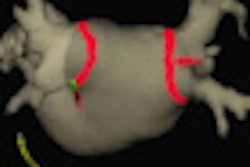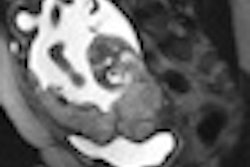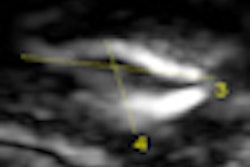
At the SPIE Medical Imaging conference held February 13-18 in San Diego, Hynynen explained how focused ultrasound can achieve targeted ablation through the skull. "For many years, people believed it was not possible to use focused ultrasound in the brain," he told the assembled delegates. Problems arise when the ultrasound beam traverses the skull, as this defocuses the beam, as well as causing the skull to heat up. "So in early research, the skull bone was removed," he noted.
The heating problem has now been addressed with the introduction of multielement hemispherical transducers. Meanwhile, CT scans of the skull can be used to calculate phase delays for each transducer and correct for skull-induced beam distortion. "We now know that we can treat the middle of the brain relatively precisely," Hynynen explained. "But some areas are still problematic -- for example, tumors near the skull base."
One way to minimize skull-base heating is to reduce the total applied power. But this must be done while still achieving ablation at the focus. The answer: "Use microbubbles," Hynynen said. Bubbles injected into the bloodstream will increase absorption at the acoustic focus, enabling equivalent biological effects with less acoustic pressure.
Tests in rabbit brains, for example, have shown that the presence of such microbubbles allowed a fourfold reduction in power. Hynynen and colleagues are currently developing models to simulate bubble-enhanced heating within the vasculature. "The use of microbubbles looks promising for being able to reduce the applied power and lower skull-base heating," he said.
Blood-brain barrier disruption
But focused ultrasound can do so much more than just ablate brain tumors. A host of other ultrasound-based applications are available that could prove valuable for treating brain diseases, according to Hynynen.
For example, more than 95% of drugs used to treat central nervous system disorders don't penetrate the blood-brain barrier. Using a focused ultrasound beam to locally disrupt the barrier, without damaging the brain, could enable the use of a far greater range of drugs. It could also allow delivery of higher doses, as the nontargeted areas of the brain remain protected by the blood-brain barrier.
Hynynen cited an example in which injection of microbubbles followed by 20 seconds of sonication opened the blood-brain barrier, allowing the drug to enter only the sonicated area. Experiments in pigs have shown that focused ultrasound can also disrupt the blood-brain barrier in large animals. "Local MRI-guided disruption of the blood-brain barrier is feasible and doesn't have an adverse effect on the animals," he said.
Most chemotherapy drugs are also incapable of penetrating the brain. Hynynen described a study looking at chemotherapy of a rat brain tumor. Rats were injected with doxorubicin and microbubbles, and sonication applied. While neither doxorubicin alone nor ultrasound alone had any impact upon the animals' survival, the combination of sonication plus drug halved the tumor doubling time and increased survival.
Hynynen also highlighted a preliminary study in which focused ultrasound was employed to treat Alzheimer's disease in a mouse model. Here, ultrasound-induced disruption of the blood-brain barrier enabled delivery of antibodies that clear amyloid beta plaques in the brain. Mice were treated with the antibodies and ultrasound applied to one side of the brain. Four hours later, antibodies were detected only on the sonicated side. After four days, fewer plaques were found on the ultrasound-treated side.
Finally, Hynynen discussed the use of ultrasound as a potential treatment for stroke. In the Combined Lysis of Thrombus in Brain Ischemia with Transcranial Ultrasound and Systemic tPA (CLOTBUST) trial, for example, adding ultrasound exposure to patients receiving the clot-dissolving drug tissue plasminogen activator (tPA) was seen to enhance its effects. Elsewhere, an in vivo study of femoral arteries in rabbits showed that high-intensity focused ultrasound could eliminate clots in some animals and restore blood flow without the need for drugs.
By Tami Freeman
Medicalphysicsweb editor
March 15, 2010
Related Reading
Focused US group nears $1M in grants, January 22, 2010
Swiss group performs transcranial HIFU, June 23, 2009
HIFU breast cancer treatment may leave immunity-building antigens, February 26, 2007
High-intensity focused ultrasound effective against high-risk prostate cancer, January 16, 2007
© IOP Publishing Limited. Republished with permission from medicalphysicsweb, a community Web site covering fundamental research and emerging technologies in medical imaging and radiation therapy.



















